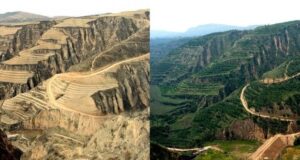The Loess Plateau, an area covering 640,000 square kilometers in China’s north-central region, was a highly fertile land in the past. However, centuries of deforestation, overgrazing, and unsustainable farming led to severe soil erosion, leaving behind a dry, unproductive landscape. By the late 20th century, the plateau was one of the most eroded regions in the world, with residents facing poverty and food scarcity.
John D. Liu, an ecologist and filmmaker, documented the devastating effects of this degradation, revealing the ecological and human crisis it had created. His observations inspired Liu to restore the land, leading to a ground project that would end up transforming the region.
His observations inspired Liu to restore the land, leading to a ground project that would end up transforming the region.

Key Principles of the Restoration Effort
The Loess Plateau restoration, led by the Chinese government with support from the World Bank and ecologists like Liu, was grounded in sustainable land management and regenerative practices. Some of the principles used were:
- Revegetation – Planting vegetation that could help anchor the soil and restore ground cover, therefore preventing erosion.
- Water Management – Terraced slopes capture rainfall and reduce runoff and better use of the water in the ground.
- Soil Enrichment – Improving soil quality through organic materials and careful management of grazing to avoid overuse.
Results
The impact of the Loess Plateau restoration was profound. Within just a few years, previously barren hillsides turned green, erosion slowed, and the plateau began to sustain diverse plant and animal life. Crops flourished, and the incomes of local residents increased dramatically. As vegetation returned, water retention improved, allowing rivers to run clearer and reducing flood risks downstream. Liu reflected on the transformation with awe:
The success of the Loess Plateau project inspired some other large-scale ecological restoration initiatives around the world. Liu went on to establish the **Ecosystem Restoration Camps** network, which promotes regenerative practices globally and empowers local communities to restore degraded landscapes.
Global Inspiration
The success of the Loess Plateau serves as a powerful example of how regenerative practices can address some of the most pressing environmental challenges, including climate change, biodiversity loss, and desertification. Liu’s work has inspired the growth of regenerative agriculture practices and environmental restoration, highlighting the interconnectedness of ecological health and human well-being.
The Loess Plateau restoration showed that degraded landscapes can be revitalized not only to sustain local communities but also to contribute to global environmental resilience. Liu’s ongoing advocacy reminds us of our agency to restore ecosystems, mitigate climate change, and secure a more sustainable planet for all living things in the planet and future generations.
Additional Resources
Reach Out
We love talking about what we do and how it can make a difference to you.


